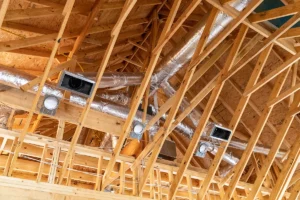At Summers Comfort Heating & Air, we get this question all the time: “What is CFM, and why does it matter?” Whether you’re dealing with uneven airflow or trying to size a new HVAC system, understanding this simple measurement can make a big difference in your home’s comfort and energy efficiency.
So let’s break it down—without the jargon—so you can feel confident about what’s flowing through your vents.
What Is CFM in HVAC Terms?
CFM stands for Cubic Feet per Minute. It’s a measurement of airflow—specifically, how much air moves through your HVAC system every minute. When someone asks what is CFM, they’re really asking, how strong is the airflow in my system?
To put it simply:
Higher CFM = more air moving through the system
Lower CFM = less air circulation
Getting the CFM right is essential. If it’s too low, your system may struggle to cool or heat your space. If it’s too high, it can cause noise, drafts, or even stress on your ductwork.
Why Does CFM Matter in Home Comfort?
Even if your equipment is high-quality, improper airflow will throw everything off. Imagine having a powerful AC unit but barely feeling cool air in certain rooms. That’s likely a CFM problem.
Your home’s comfort depends on having balanced airflow. The right CFM ensures:
Even temperatures across all rooms
Proper humidity control
Efficient heating and cooling cycles
Improper installation—especially airflow or duct issues—can significantly reduce HVAC system efficiency. According to the U.S. Department of Energy, properly sealed and insulated ducts help minimize energy losses and moderate airflow. In our experience, airflow and duct problems are among the most common causes of reduced comfort and higher bills.
Proper airflow also helps your HVAC system perform at its rated SEER level. Without enough CFM, even a high-efficiency unit won’t deliver its full cooling potential. That means higher energy bills and less comfort—despite the SEER rating on the label. Curious how SEER impacts your energy use? Check out our SEER calculator here to estimate your potential savings.
Why CFM Is Key to Proper System Sizing and Duct Design

When we install or replace a system, we don’t just pick a unit based on square footage. Instead, we calculate the required cubic feet per minute to match your home’s load, layout, and ductwork.
As a general guideline:
A typical HVAC system requires 400 CFM per ton of cooling capacity
A 2.5-ton AC would need roughly 1,000 CFM to work properly
Of course, that’s just a starting point. We also factor in:
Ceiling height
Insulation levels
Duct sizing
Number of vents and returns
That’s why we never recommend guessing your system size or going by square footage alone.
What Is CFM and How Do You Measure It?
There are a few ways to measure CFM, and most of them require special tools. At Summers Comfort, we use:
Anemometers to measure air velocity at supply vents
Flow hoods to assess airflow volume
Static pressure testing to evaluate restrictions or imbalances
We then compare actual CFM readings to what your system should be delivering. If there’s a gap, we troubleshoot until it’s right.
To understand how airflow and duct performance affect efficiency, check out this ENERGY STAR guide on duct sealing.
Signs Your CFM Might Be Off
Still wondering about CFM and whether yours is correct? Here are some clues your airflow might need attention:
Hot or cold spots in different rooms
Excessive dust around vents
Weak airflow from one or more registers
Short cycling (your system turns on/off too frequently)
High energy bills despite moderate thermostat settings
These are all signs something’s out of balance—and airflow is often the first place we look.
What Is CFM’s Role in Indoor Air Quality?
Good airflow does more than regulate temperature. It also impacts air quality.
If your CFM is too low, your home may not get enough air exchanges per hour. That means dust, pollen, and humidity can build up. Over time, this can lead to discomfort—or worse, respiratory issues.
According to the EPA, poor ventilation is a key contributor to indoor air pollution. Proper CFM ensures your system can move and filter air effectively.
Can You Adjust CFM in an Existing System?
In many cases, yes. Here are a few ways HVAC professionals can fine-tune your system’s CFM:
Adjusting fan speed settings on the air handler
Installing dampers to balance airflow
Modifying or resizing ductwork
Cleaning or replacing filters
Inspecting for leaks or restrictions
Sometimes a simple fix—like removing a blockage in a return vent—can significantly improve airflow.
Summary
So, what is CFM? It’s the number that tells us whether your HVAC system is delivering the airflow your home needs. It affects comfort, efficiency, and air quality. And at Summers Comfort Heating & Air, it’s one of the first things we check when we assess your system.
If you’re dealing with inconsistent airflow, hot rooms, or weak ventilation, it could be a CFM issue—and we can help.
We serve homeowners in Gastonia, Baton Rouge, Walker, Prairieville, and the surrounding areas. Whether you need airflow balancing, HVAC repair, or a full system upgrade, give us a call or schedule your service online. We’ll make sure your home feels just right—every room, every season.

